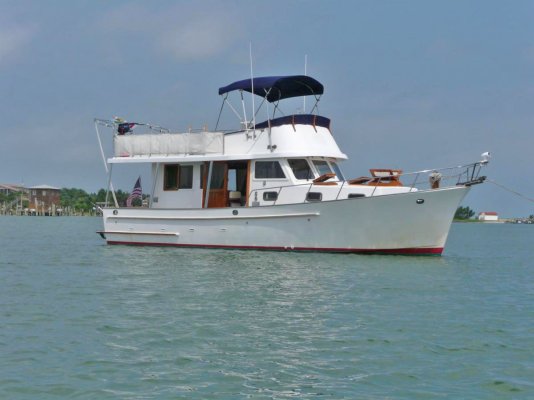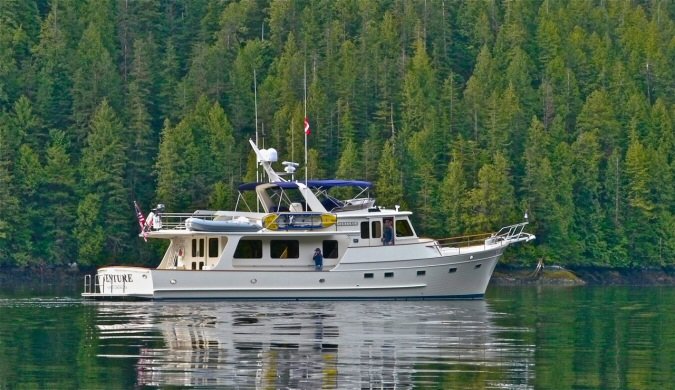You are using an out of date browser. It may not display this or other websites correctly.
You should upgrade or use an alternative browser.
You should upgrade or use an alternative browser.
boats similar to 36ft grand Banks Europa ?
- Thread starter roguewave
- Start date
The friendliest place on the web for anyone who enjoys boating.
If you have answers, please help by responding to the unanswered posts.
If you have answers, please help by responding to the unanswered posts.
Daddyo
Guru
Our boat until two years ago! MT 36 Sedan.
Attachments
Last edited:
While I am not a big fan of the GB design from an aesthetic standpoint I will say there are not many boats out there I am familiar with that have had the same consistency of high quality construction and components starting in 1964 with the wood boats and carrying on into the glass boats in 1973 on up to today.
The multitude of so-called Taiwan Trawlers have their good and bad qualities but their consistency left a lot to be desired, at least in the 70s and 80s. You can find a good one but you'd better have a surveyor who's really familiar with the idiosyncrasies of the Taiwan boats' building methods and practices.
For this reason, when we started our quest for a diesel cruiser to buy we immediately ruled out all the Taiwan Trawler brands--- CHB, Marine Trader, Puget Trawler, ad infinitum. We didn't have a lot of time to devote to the boat-buying process and we didn't want to spend any of it sorting through tons of crappy boats in search of the occasional good one.
What was left in the price range we were looking at were Grand Banks, Island Gypsy, Nordic Tug, Victory Tug, and Tollycraft. (Victory Tugs were built in Taiwan but not in the same yards or manner as the TT boats.)
Tollycraft we ruled out immediately because neither one of us likes that style of boat although they are very well built, have good reputations, and are very plentiful in this area since they were built here.
The tugs are cool boats and we really like their lines, particularly the Victory Tug, but we decided that we would get better service from a tri-cabin boat. Also the earlier Victory Tugs were powered with a somewhat iffy engine, at least in terms of parts and service availability.
In the end we went with our own preferences plus the "strongly worded" recommendations of several friends who had spent their careers in the marine industry (marine diesel manufacturing and boatyard management). So we got a Grand Banks and have not regretted it for a moment in the last 14-plus years although there are designs we much prefer from an aesthetic standpoint.
So my own recommendation for someone wanting a production tri-cabin or Europa-style, semi-planing diesel cruiser in the 32' to 42' range and has a boating budget $100,000 to $250,000 is to go with either Grand Banks or Island Gypsy/Kong & Halverson.
If you like the tug-style boats I don't think you can go wrong with a Nordic Tug. American Tugs are supposed to be good too, but I don't care for their looks so have paid no attention to them.
Obviously any make of boat, no matter how well made, can be abused or neglected into rubbish condition by its previous owners. So brand is not an automatic indicator of a good boat. But I feel it very definitely is an indicator of initial quality and that often means a boat will stand up better to neglect or even abuse than other brands.
If a good-to-excellent condition GB, IG, etc. is not within the budget here is a link to an article about the Taiwan boats you might find useful as you evaluate potential candidates. http://www.bluehorizonsailing.net/wp-content/uploads/2012/02/venerable_taiwanese_trawlers.pdf
PS--- There are, of course, a ton of different production boat brands and styles that I have not mentioned here. Some of them, like lobsterboats, have tremendous aesthetic appeal to us but other than the one owned by a good friend we know very little about these boats.
Others, like Mainship, Californian, Uniflite, Carver, ChrisCraft, Bayliner, SeaRay and many others have no aesthetic appeal to us at all and so we have not bothered to learn much or anything about them. And some brands we like from an aesthetic aspect but have not had much opportunity to learn about like Krogens and (some) Willards.
Most of the major brands are represented on this forum so I'm sure you will get all sorts of comments, pro and con, on all of them eventually.
The multitude of so-called Taiwan Trawlers have their good and bad qualities but their consistency left a lot to be desired, at least in the 70s and 80s. You can find a good one but you'd better have a surveyor who's really familiar with the idiosyncrasies of the Taiwan boats' building methods and practices.
For this reason, when we started our quest for a diesel cruiser to buy we immediately ruled out all the Taiwan Trawler brands--- CHB, Marine Trader, Puget Trawler, ad infinitum. We didn't have a lot of time to devote to the boat-buying process and we didn't want to spend any of it sorting through tons of crappy boats in search of the occasional good one.
What was left in the price range we were looking at were Grand Banks, Island Gypsy, Nordic Tug, Victory Tug, and Tollycraft. (Victory Tugs were built in Taiwan but not in the same yards or manner as the TT boats.)
Tollycraft we ruled out immediately because neither one of us likes that style of boat although they are very well built, have good reputations, and are very plentiful in this area since they were built here.
The tugs are cool boats and we really like their lines, particularly the Victory Tug, but we decided that we would get better service from a tri-cabin boat. Also the earlier Victory Tugs were powered with a somewhat iffy engine, at least in terms of parts and service availability.
In the end we went with our own preferences plus the "strongly worded" recommendations of several friends who had spent their careers in the marine industry (marine diesel manufacturing and boatyard management). So we got a Grand Banks and have not regretted it for a moment in the last 14-plus years although there are designs we much prefer from an aesthetic standpoint.
So my own recommendation for someone wanting a production tri-cabin or Europa-style, semi-planing diesel cruiser in the 32' to 42' range and has a boating budget $100,000 to $250,000 is to go with either Grand Banks or Island Gypsy/Kong & Halverson.
If you like the tug-style boats I don't think you can go wrong with a Nordic Tug. American Tugs are supposed to be good too, but I don't care for their looks so have paid no attention to them.
Obviously any make of boat, no matter how well made, can be abused or neglected into rubbish condition by its previous owners. So brand is not an automatic indicator of a good boat. But I feel it very definitely is an indicator of initial quality and that often means a boat will stand up better to neglect or even abuse than other brands.
If a good-to-excellent condition GB, IG, etc. is not within the budget here is a link to an article about the Taiwan boats you might find useful as you evaluate potential candidates. http://www.bluehorizonsailing.net/wp-content/uploads/2012/02/venerable_taiwanese_trawlers.pdf
PS--- There are, of course, a ton of different production boat brands and styles that I have not mentioned here. Some of them, like lobsterboats, have tremendous aesthetic appeal to us but other than the one owned by a good friend we know very little about these boats.
Others, like Mainship, Californian, Uniflite, Carver, ChrisCraft, Bayliner, SeaRay and many others have no aesthetic appeal to us at all and so we have not bothered to learn much or anything about them. And some brands we like from an aesthetic aspect but have not had much opportunity to learn about like Krogens and (some) Willards.
Most of the major brands are represented on this forum so I'm sure you will get all sorts of comments, pro and con, on all of them eventually.
Last edited:
JohnP
Guru
- Joined
- Dec 13, 2009
- Messages
- 1,361
- Location
- USA
- Vessel Name
- V E N T U R E
- Vessel Make
- 1996 36' Island Gypsy Classic
The IG 36 is quite simular to the Grandbanks version. The Island Gypsy build quality is excellent.
We are happy with our 32 and I think the design gives a drier ride with a little more flare to the bow.
Island Gypsies are a less known make and I think you could get more bang for your buck without the Grandbanks markup.
JohnP
We are happy with our 32 and I think the design gives a drier ride with a little more flare to the bow.
Island Gypsies are a less known make and I think you could get more bang for your buck without the Grandbanks markup.
JohnP
Nomad Willy
Guru
From pics I've seen I know the GB has considerably more deadrise and is closer to (but still far from) a disp hull. The IG transom is submerged deeper in the water causing more drag.
One could say the IG has a flatter bottom and greater stability in most situations but the GB is a wide boat and has lots of stability. One could say the IG has a hull more suitable to higher speeds but very few seem to be interested in greater speeds.
What is the draft and displacement differences? I would think the GB is a bit deeper and heavier but I really don't know.
I see most here travel at about 8 knots perhaps 7.5. Does anyone know which boat is more easily driven?
The GB probably has less windage.
IGs probably cost less. GBs have a reputation of being a very well built higher quality boat. What's actually better .... if anything.
All other things being equal I'd probably choose the GB for the hull. When I was looking at other boats I looked at quite a number of IGs and few GBs. But it seems to me there were more IGs available.
Unlike most of you I don't like the looks of the Europa's w those vertical slabs that support the overhanging roof. If I had one of those boats I'd take out those "slabs" and substitute vertical metal tubes that would basically disappear visually. The IGs have (as already mentioned) more flair and are probably better looking fwd as a result. As I recall the IGs have a flatter stern w less curve = not as attractive.
All that said though if all things were basically equal I'd turn my back on both and get a Nordic Tug.
MT Nest,
I see your post now and I agree. The Monk may in fact be more similar to the GB than the IG. I think the biggest difference between the Monk and the GB is the freeboard. I'd choose the lower freeboard GB but I'll bet most would prefer the higher hull of the Monk. Looking at Woodies Monk and thoughts of GBs sorta disappear.
One could say the IG has a flatter bottom and greater stability in most situations but the GB is a wide boat and has lots of stability. One could say the IG has a hull more suitable to higher speeds but very few seem to be interested in greater speeds.
What is the draft and displacement differences? I would think the GB is a bit deeper and heavier but I really don't know.
I see most here travel at about 8 knots perhaps 7.5. Does anyone know which boat is more easily driven?
The GB probably has less windage.
IGs probably cost less. GBs have a reputation of being a very well built higher quality boat. What's actually better .... if anything.
All other things being equal I'd probably choose the GB for the hull. When I was looking at other boats I looked at quite a number of IGs and few GBs. But it seems to me there were more IGs available.
Unlike most of you I don't like the looks of the Europa's w those vertical slabs that support the overhanging roof. If I had one of those boats I'd take out those "slabs" and substitute vertical metal tubes that would basically disappear visually. The IGs have (as already mentioned) more flair and are probably better looking fwd as a result. As I recall the IGs have a flatter stern w less curve = not as attractive.
All that said though if all things were basically equal I'd turn my back on both and get a Nordic Tug.
MT Nest,
I see your post now and I agree. The Monk may in fact be more similar to the GB than the IG. I think the biggest difference between the Monk and the GB is the freeboard. I'd choose the lower freeboard GB but I'll bet most would prefer the higher hull of the Monk. Looking at Woodies Monk and thoughts of GBs sorta disappear.
Last edited:
Codger2
Guru
- Joined
- Oct 11, 2007
- Messages
- 6,691
- Location
- US
- Vessel Name
- Circuit Breaker
- Vessel Make
- 2021..22' Duffy Cuddy cabin
The IG 36 is quite simular to the Grandbanks version. The Island Gypsy build quality is excellent.
 & have posted this comparison before as it is the only one I can find that is not connected to either brand. I should also mention that I'm a big fan of the GB Euros but if "bang for the buck" is important to you, then the IGs win out in my mind.
& have posted this comparison before as it is the only one I can find that is not connected to either brand. I should also mention that I'm a big fan of the GB Euros but if "bang for the buck" is important to you, then the IGs win out in my mind.Attachments
Daddyo
Guru
MT,
We are talking about Europa style sedans not aft cabins.
GB, MT, IG
We are talking about Europa style sedans not aft cabins.
GB, MT, IG
Attachments
One thing that might or might not be important to a potential buyer is that a Grand Banks, at least in the smaller 32 and 36 sizes, is a VERY wet boat in quartering seas with a wind, which there usually is if there are waves. The Kenneth Smith-designed hull has very little flare in the forebody (see photo) so what happens is that quartering waves whack against the side of the hull and shoot straight up. With hardly any flare the water continues up past the gunwale and into the air at which point the wind pushes all of it onto the boat and into the windows.
Now we think this is neat as it makes an otherwise routine seven mile crossing of Bellingham Bay, which is very susceptible to very steep, very closely spaced wind waves, a bit more interesting. Our boat has excellent wipers which do a great job of clearing the glass and all the salt water coming aboard and running down the teak deck is good for the subdeck. So we think this "wet boat" thing is kind of fun.
But it seems to bug a lot of other boaters for whatever reasons. Now I've never been out on an Island Gypsy nor have I ever observed one underway in the same situation I've described above. So I have no idea how they behave in rougher conditions. But I've seen tons of GBs as we cruise as I suspect they are more numerous here and in BC than anywhere else on the planet as the cruising waters here are perfect fror this kind of coastal/inside waters boat.
And when it's rough and a GB is heading into the waves on a windy day, the entire front of the boat is enveloped in spray pretty much continuously.
GBs are heavy with a very deep forefoot and a wide, fairly flat, hard-chine afterbody so they handle rough water extremely well. I'm talking our rough water which has no swells at all but just closely spaced, steep faced wind waves, albeit wind waves that can get up to five and six feet high at times. Going into these waves, either directly or at an angle, is a hoot if you like that sort of thing.
Going down them is a giant pain in the ass--- literally--- as at seven or eight knots the waves are going faster than the boat so they slam into that wide, flat transom and shove the boat towards all points in the compass.
We have friends with newer and fancier GBs than ours and they have autopilots (we removed the autopilot from our boat). They have told us that there are conditions going downsea in which they have to disengage the autopilot and steer by hand because an autopilot can only react, it cannot anticipate. So the autopilot is always way behind the curve, trying to compensate for a serious yaw that has happened so hard and so fast that the reaction of the autopilot is too little, too late and the situation simply gets worse and worse.
As we steer entirely by hand I know what they are talking about. Anticipatory action with the helm is actually more critical to maintaining control and course than the reaction when the stern is shoved violently sideways. By getting into the "rhythm" of the waves, one can start compensating for what is about to happen before it does, and the end result is a pretty consistent course heading and a much less violent ride. An autopilot cannot do this.
I don't particularly mind this as it's an enjoyable challenge to try to anticipate exactly what the next big shove will do and time it just right so I get the boat started into its correction just before the wave hits and so negate the yawing action almost completely. But doing this across Bellingham Bay, for example, at the end of a cruise with a strong south or southeast wind can tiring as it takes the best part of an hour to cross the bay at eight knots.
The Ken Smith GB hull also has a fairly "violent" snap-back at the end of every roll. This is characteristic of this type of flat-afterbody, hard-chine hull. Eric will know a lot more about why this hull configuration has this characteristic, but it means that while the hull is quite stable under normal conditions (however you define that) when the conditions are such that the boat gets to rolling, it is not a gentle roll as one typically gets in a rounder displacement hull. Instead it is a much more sudden back-and-forth movement with a rapid and even jerky change of direction at the end of every roll. Some people prefer this to the longer, more "swoopy" roll of a displacement hull, some hate it.
Now we think this is neat as it makes an otherwise routine seven mile crossing of Bellingham Bay, which is very susceptible to very steep, very closely spaced wind waves, a bit more interesting. Our boat has excellent wipers which do a great job of clearing the glass and all the salt water coming aboard and running down the teak deck is good for the subdeck. So we think this "wet boat" thing is kind of fun.
But it seems to bug a lot of other boaters for whatever reasons. Now I've never been out on an Island Gypsy nor have I ever observed one underway in the same situation I've described above. So I have no idea how they behave in rougher conditions. But I've seen tons of GBs as we cruise as I suspect they are more numerous here and in BC than anywhere else on the planet as the cruising waters here are perfect fror this kind of coastal/inside waters boat.
And when it's rough and a GB is heading into the waves on a windy day, the entire front of the boat is enveloped in spray pretty much continuously.
GBs are heavy with a very deep forefoot and a wide, fairly flat, hard-chine afterbody so they handle rough water extremely well. I'm talking our rough water which has no swells at all but just closely spaced, steep faced wind waves, albeit wind waves that can get up to five and six feet high at times. Going into these waves, either directly or at an angle, is a hoot if you like that sort of thing.
Going down them is a giant pain in the ass--- literally--- as at seven or eight knots the waves are going faster than the boat so they slam into that wide, flat transom and shove the boat towards all points in the compass.
We have friends with newer and fancier GBs than ours and they have autopilots (we removed the autopilot from our boat). They have told us that there are conditions going downsea in which they have to disengage the autopilot and steer by hand because an autopilot can only react, it cannot anticipate. So the autopilot is always way behind the curve, trying to compensate for a serious yaw that has happened so hard and so fast that the reaction of the autopilot is too little, too late and the situation simply gets worse and worse.
As we steer entirely by hand I know what they are talking about. Anticipatory action with the helm is actually more critical to maintaining control and course than the reaction when the stern is shoved violently sideways. By getting into the "rhythm" of the waves, one can start compensating for what is about to happen before it does, and the end result is a pretty consistent course heading and a much less violent ride. An autopilot cannot do this.
I don't particularly mind this as it's an enjoyable challenge to try to anticipate exactly what the next big shove will do and time it just right so I get the boat started into its correction just before the wave hits and so negate the yawing action almost completely. But doing this across Bellingham Bay, for example, at the end of a cruise with a strong south or southeast wind can tiring as it takes the best part of an hour to cross the bay at eight knots.
The Ken Smith GB hull also has a fairly "violent" snap-back at the end of every roll. This is characteristic of this type of flat-afterbody, hard-chine hull. Eric will know a lot more about why this hull configuration has this characteristic, but it means that while the hull is quite stable under normal conditions (however you define that) when the conditions are such that the boat gets to rolling, it is not a gentle roll as one typically gets in a rounder displacement hull. Instead it is a much more sudden back-and-forth movement with a rapid and even jerky change of direction at the end of every roll. Some people prefer this to the longer, more "swoopy" roll of a displacement hull, some hate it.
Attachments
Last edited:
I see most here travel at about 8 knots perhaps 7.5. Does anyone know which boat is more easily driven?
Can't give you any comparison. But two data points that might help-- or not--- are:
The single engine GB 36 we chartered before buying our own boat was fitted with a Cummins 210hp diesel. Two thousand RPM pushed the boat along at 8.5 knots. Don't know the fuel consumption, don't know the prop specs.
Our twin engine GB36 with four bladed props, 23" diameter x 16" pitch with two 120 hp engines running at 1650 cruises at about 8 knots and burns a total of a little over 5 gallons per hour in the process (we use 6gph for calculating purposes).
Codger2
Guru
- Joined
- Oct 11, 2007
- Messages
- 6,691
- Location
- US
- Vessel Name
- Circuit Breaker
- Vessel Make
- 2021..22' Duffy Cuddy cabin
One thing that might or might not be important to a potential buyer is that a Grand Banks, at least in the smaller 32 and 36 sizes, is a VERY wet boat in quartering seas with a wind, which there usually is if there are waves.............same here.(32)
Our boat has excellent wipers which do a great job of clearing the glass...........same here.(32)
Now I've never been out on an Island Gypsy nor have I ever observed one going in the same situation I've described above. So I have no idea how they behave in rougher conditions.....same way.(32)
And when it's rough and a GB is heading into the waves, the entire front of the boat is enveloped in spray pretty much continuously. Same here. (32)
They have told us that there are conditions going downsea in which they have to disengage the autopilot and steer by hand because an autopilot can only react,* it cannot anticipate. So the autopilot is always way behind the curve, ....*The new APs are "learning pilots" and this is less of a problem as the manufacturers constantly improve their APs.
As the quality and AI (artificial intelligence) of APs evolve, I can see the day in the not too distant future where the APs can & will anticipate more accurately, the effects of a following sea than can a helmsman.
http://www.furunousa.com/ProductDocuments/Navpilot500%20Brochure.pdf
Last edited:
As the quality and AI (artificial intelligence) of APs evolve, I can see the day in the not too distant future where the APs can & will anticipate more accurately, the effects of a following sea than can a helmsman.
http://www.furunousa.com/ProductDocuments/Navpilot500%20Brochure.pdf
The six-speed transmission in our new truck "learns" how I drive and so adjusts its shifting patterns accordingly. However, it has no way of knowing what is coming on the road, if a hill is ahead for example, or a sharp curve I have to slow down for, or a construction site that forces stops and goes on what otherwise would be an open stretch of road.
Same with an autopilot. Short of mounting sensors on the aft end of the boat to detect and measure the speed, height, slope, mass, and strike angle of an oncoming wave, and then compare that with all the known parameters of your boat's reaction to being hit by such a wave, there is no way for an autopilot, "smart" or otherwise, to know in advance of a wave's arrival at your transom when that wave is coming, how fast it is coming, how hard it will hit the boat, and how the boat will react to it.
Not saying it's not possible to do this but I suspect that if such a system is created the cost of development and the cost of the components and software will make this a device that is far outside the reach of most recreational boaters for the foreseeable future.
So until then we steer by hand and everyone we know with autopilots turns them off under these conditions.
Last edited:
Max Simmons
Guru
- Joined
- Oct 15, 2007
- Messages
- 805
- Vessel Make
- Ocean Alexander 38'
Daddyo
Guru
I've had wet boats Albin 27 Sport Cruiser, Semi-dry Marine Trader 36 Sedan and very dry DeFever 48 and I've got to say the dry is a lot nicer in my thinking. Not to mention the reserve buoyancy forward is a real blessing in head seas. We accidentally got the 8' bow nearly 20' out of the water thanks to a ship in a tight channel in Charleston. That buoyancy may have saved our souls when we slammed into the trough.
JohnP
Guru
- Joined
- Dec 13, 2009
- Messages
- 1,361
- Location
- USA
- Vessel Name
- V E N T U R E
- Vessel Make
- 1996 36' Island Gypsy Classic
I've had wet boats Albin 27 Sport Cruiser, Semi-dry Marine Trader 36 Sedan and very dry DeFever 48 and I've got to say the dry is a lot nicer in my thinking. Not to mention the reserve buoyancy forward is a real blessing in head seas. We accidentally got the 8' bow nearly 20' out of the water thanks to a ship in a tight channel in Charleston. That buoyancy may have saved our souls when we slammed into the trough.
I think the Defever 48' is one of the most beautiful trawler designs I have seen. I think the PH models are built too high and the 48's bow is a work of Art. Pun intended.
The chances of me getting a big boat in the future are slim, but I know I would give the 48'Defever a good hard look if I were in the market.
Take care, JohnP
On the subject of boat appearance, and acknowledging that aesthetics are totally subjective, of the deFever designs I don't like any of them except the deFever 46. The non-raised pilothouse-style boats like the 48 TO ME are very run-of-the-mill, plain-Jane designs. They have no features of particular interest, the flying bridge is awkwardly positioned, at least on the 48, and there are other things about the one-level designs I don't care for.
The deFever pilohouse boats, on the other hand, particularly the 46' which I think hits the proportions just right, are outstanding to my way of thinking.
But actually I don't think even any of the branded deFever pilothouse designs get it quite right. Tony Fleming took the deFever pilothouse design and made it truly stunning. We've been on a few 55s with an eye to buy and they are truly beautiful inside and out.
And before Tony, American Marine put just enough spin of their own on deFever's pilothouse design to make the Alaskan 49 a spectacular boat in my opinion. If it wasn't made of wood the Alaskan 49 would be at the very top of my list of Most Perfect Recreational Production Boats Not Based on a Working Boat Design. (I like the lobsterboat and salmon troller designs better.) But since the Alaskan 49 IS made of wood, that bumps it to number two and moves the Fleming 55 to the top of the list.
Obviously I think the raised pilothouse design is the best recreational-style boat design around. Whether it's a 1940s salmon troller or a brand new Fleming 55, to me the raised pilothouse boats epitomize what I think a boat of this type should look like. The all-on-one-level boats like the deFever 48, all the Grand Banks, etc. just don't do it for me aesthetically.
Were we to ever buy a different boat it would very likely not be a Grand Banks although for this design the GB46 (the original model, not the screwed-up final model) gets it just about perfect in our opinions.
The deFever pilohouse boats, on the other hand, particularly the 46' which I think hits the proportions just right, are outstanding to my way of thinking.
But actually I don't think even any of the branded deFever pilothouse designs get it quite right. Tony Fleming took the deFever pilothouse design and made it truly stunning. We've been on a few 55s with an eye to buy and they are truly beautiful inside and out.
And before Tony, American Marine put just enough spin of their own on deFever's pilothouse design to make the Alaskan 49 a spectacular boat in my opinion. If it wasn't made of wood the Alaskan 49 would be at the very top of my list of Most Perfect Recreational Production Boats Not Based on a Working Boat Design. (I like the lobsterboat and salmon troller designs better.) But since the Alaskan 49 IS made of wood, that bumps it to number two and moves the Fleming 55 to the top of the list.
Obviously I think the raised pilothouse design is the best recreational-style boat design around. Whether it's a 1940s salmon troller or a brand new Fleming 55, to me the raised pilothouse boats epitomize what I think a boat of this type should look like. The all-on-one-level boats like the deFever 48, all the Grand Banks, etc. just don't do it for me aesthetically.
Were we to ever buy a different boat it would very likely not be a Grand Banks although for this design the GB46 (the original model, not the screwed-up final model) gets it just about perfect in our opinions.
Last edited:
markpierce
Master and Commander
- Joined
- Sep 25, 2010
- Messages
- 12,557
- Location
- USA
- Vessel Name
- Carquinez Coot
- Vessel Make
- penultimate Seahorse Marine Coot hull #6
Obviously I think the raised pilothouse design is the best recreational-style boat design around. Whether it's a 1940s salmon troller or a brand new Fleming 55, to me the raised pilothouse boats epitomize what I think a boat of this type should look like. The all-on-one-level boats like the deFever 48, all the Grand Banks, etc. just don't do it for me aesthetically.
Raised pilothouse or not, 360-degree visibility from the helmsman's position is needed.

Nomad Willy
Guru
markpierce
Master and Commander
- Joined
- Sep 25, 2010
- Messages
- 12,557
- Location
- USA
- Vessel Name
- Carquinez Coot
- Vessel Make
- penultimate Seahorse Marine Coot hull #6
So what. One's got to keep watch for passing Sea Rays and their kind.

Last edited:
markpierce
Master and Commander
- Joined
- Sep 25, 2010
- Messages
- 12,557
- Location
- USA
- Vessel Name
- Carquinez Coot
- Vessel Make
- penultimate Seahorse Marine Coot hull #6
We have 360 visibility and like it but what does all this talk of OAs, DeFevers, Coots and Willards have to do w boats similar to the GB 36????
Marin should be able to answer that.
]
Nothing really, other than perhaps the GB-type design is perhaps not the best design to be shopping for.
GBs have good visibility to the front and sides, not so much to the rear, particularly if one keeps stuff on top of the aft cabin. The rowing/sailing dinghy that came with our boat lives there and we really like having it even though it pretty much totals good visibility to the rear from inside the cabin. However the helmsperson can lean out the main cabin door and look back so rearward visibility is still pretty good.
Our boat was built with the small rear window in the main cabin to port of the companionway down to the aft cabin in addition to the large opening window to starboard. There is nothing aft of the small window so it's a clear shot to the rear. A number of GB36s were built without this window--- Lord only knows why; it's useful and not having it doesn't offer any advantage that we can see.
Obviously if one likes to drive from the flying bridge then visibility is not an issue but we never drive from up there. But we have never found the less-than-ideal rear visibility to pose any sort of problem so to us it's a non-issue.
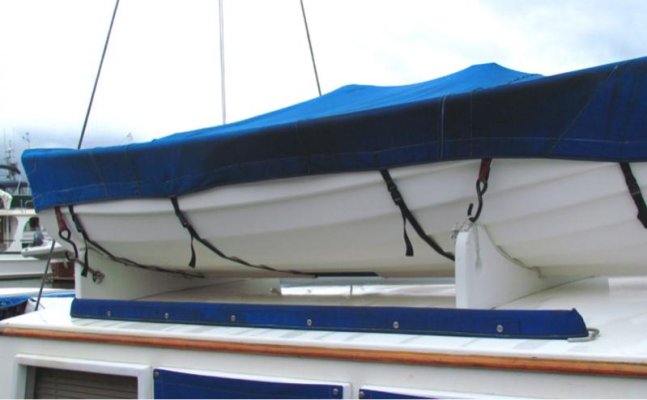

We have 360 visibility and like it but what does all this talk of OAs, DeFevers, Coots and Willards have to do w boats similar to the GB 36????
Nothing really, other than perhaps the GB-type design is perhaps not the best design to be shopping for.
GBs have good visibility to the front and sides, not so much to the rear, particularly if one keeps stuff on top of the aft cabin. The rowing/sailing dinghy that came with our boat lives there and we really like having it even though it pretty much totals good visibility to the rear from inside the cabin. However the helmsperson can lean out the main cabin door and look back so rearward visibility is still pretty good.
Our boat was built with the small rear window in the main cabin to port of the companionway down to the aft cabin in addition to the large opening window to starboard. There is nothing aft of the small window so it's a clear shot to the rear. A number of GB36s were built without this window--- Lord only knows why; it's useful and not having it doesn't offer any advantage that we can see.
Obviously if one likes to drive from the flying bridge then visibility is not an issue but we never drive from up there. But we have never found the less-than-ideal rear visibility to pose any sort of problem so to us it's a non-issue.


healhustler
Guru
- Joined
- Oct 2, 2009
- Messages
- 5,198
- Location
- USA
- Vessel Name
- Bucky
- Vessel Make
- Krogen Manatee 36 North Sea
Another amazing example of Photoshop dexterity. Do you do this for a living? If you don't, you should.
I don't like the look of the "modified" Europa at all. The lack of the wider and "streamlined" side deck supports make the boat look homemade, and by an amateur at that. It's not hideous, it just looks cheap.
I don't like the look of the "modified" Europa at all. The lack of the wider and "streamlined" side deck supports make the boat look homemade, and by an amateur at that. It's not hideous, it just looks cheap.
CPseudonym
Moderator Emeritus
Strange how subjective aesthetics are. I found the modified look much more pleasing to my eye. I tend to agree with Eric's opinion as they always looked like an afterthought to me.
Moonstruck
Guru
- Joined
- Nov 27, 2008
- Messages
- 8,276
- Location
- USA
- Vessel Name
- Moonstruck
- Vessel Make
- Sabre 42 Hardtop Express
I think they are referred to as fashion plates. Very traditional. I like them. Rather shippy I think.


tend to agree with Eric's opinion as they always looked like an afterthought to me.
They can, I'll agree with that. It depends on the overall boat design. On the boat in the photos I think it is not the best treatment of the streamlined side supports on the planet. They do have a bit of an afterthought look to them.
As opposed to a Fleming where the side supports really complement the whole look of the boat in my opinion.
Attachments
Last edited:

![MT36 010 [50%].jpg](/data/attachments/17/17959-06f8da2cf9d56c726230313f6c175e18.jpg)


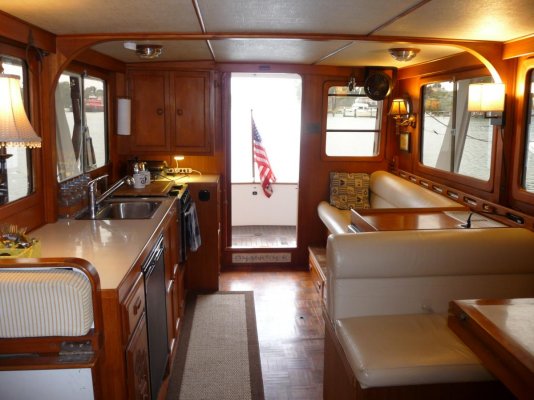


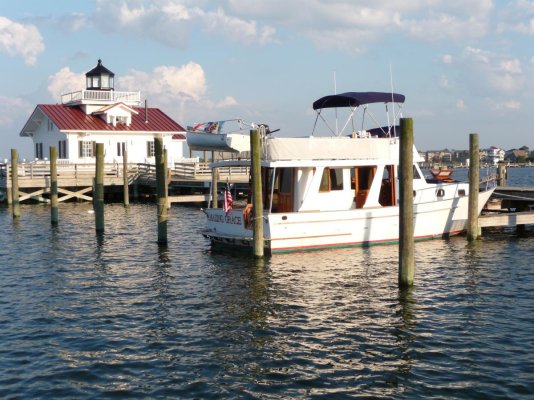

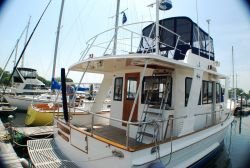
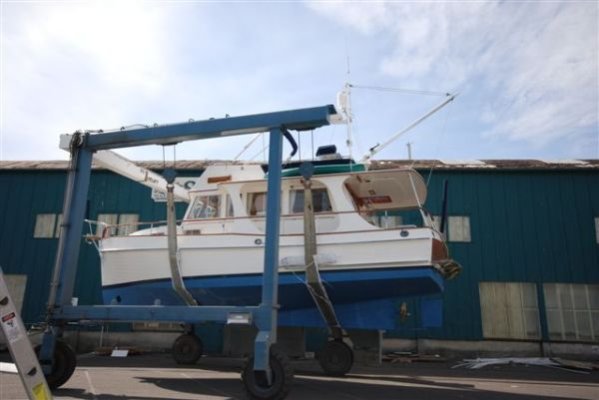
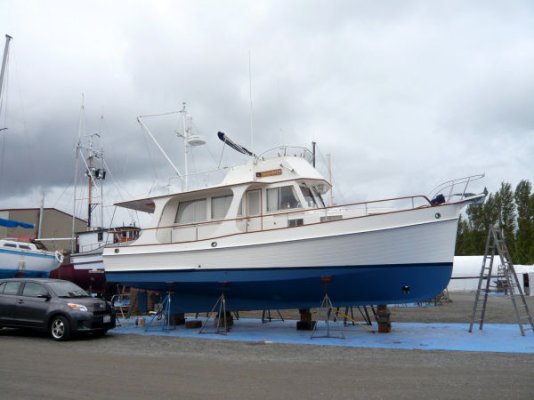
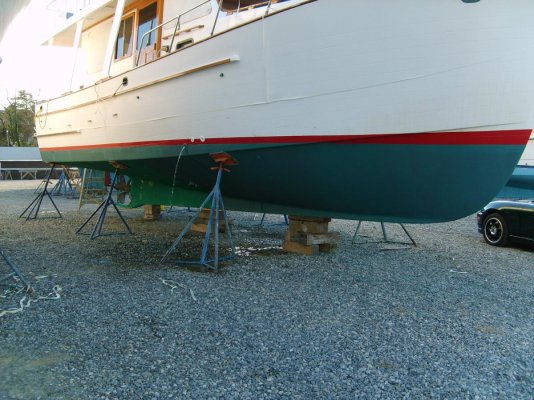

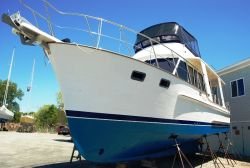
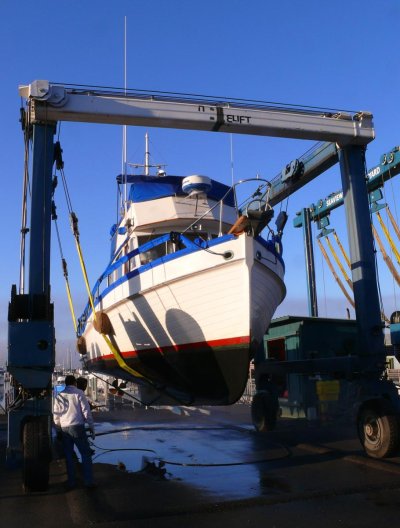

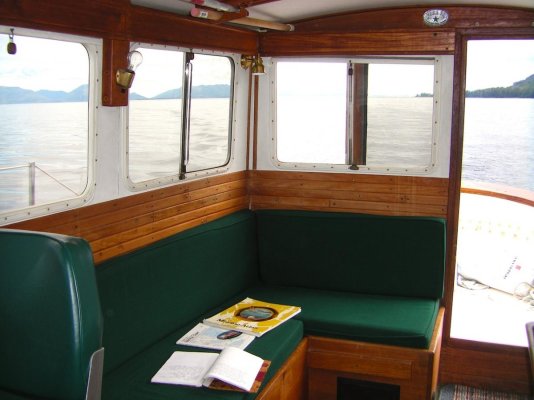
![MT36 010 [50%].jpg](/data/attachments/17/17988-06f8da2cf9d56c726230313f6c175e18.jpg)
